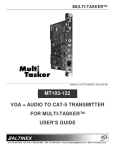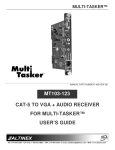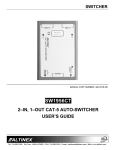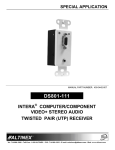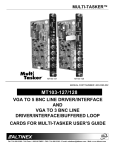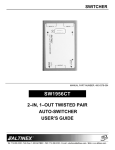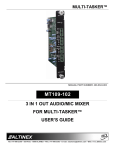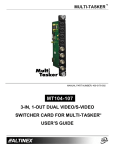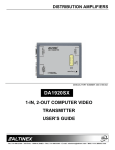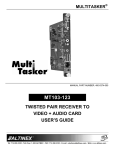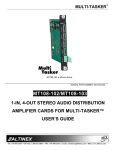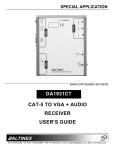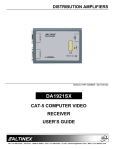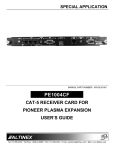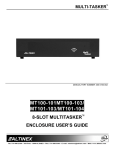Download Altinex DA1921SX User`s guide
Transcript
MULTI-TASKER™ MANUAL PART NUMBER: 400-0376-001 MT103-121 1-IN, 6-OUT CAT-5 DISTRIBUTION AMPLIFIER CARD FOR MULTI-TASKER™ ENCLOSURES USER’S GUIDE MULTI-TASKER™ TABLE OF CONTENTS Page PRECAUTIONS / SAFETY WARNINGS................ 2 GENERAL .............................................................. 2 INSTALLATION ..................................................... 2 CLEANING............................................................. 2 FCC / CE NOTICE................................................. 2 ABOUT YOUR MT103-121 ..................................... 3 TECHNICAL SPECIFICATIONS ............................ 3 PRODUCT DESCRIPTION .................................... 4 APPLICATION DIAGRAM ....................................... 5 DIAGRAM 1: TYPICAL SETUP ............................ 5 DIAGRAM 2: INTERNAL VIEW ............................ 6 DIAGRAM 3: JUMPER SETTINGS...................... 7 INSTALLING YOUR MT103-121 ........................... 8 OPERATION............................................................. 8 RS-232 CONTROL ............................................... 8 DESCRIPTION OF COMMANDS ........................ 8 SUMMARY OF COMMANDS ............................. 13 MENU MODE....................................................... 13 TROUBLESHOOTING GUIDE ............................. 15 CARD IS NOT RECOGNIZED ........................... 15 NO DISPLAY........................................................ 16 ALTINEX POLICY .................................................. 16 LIMITED WARRANTY/RETURN POLICY......... 16 CONTACT INFORMATION ................................ 16 1 MULTI-TASKER™ PRECAUTIONS / SAFETY WARNINGS • 1 Please read this manual carefully before using your MT103-121. Keep this manual handy for future reference. These safety instructions are to ensure the long life of your MT103-121 and to prevent fire and shock hazard. Please read them carefully and heed all warnings. 1.1 GENERAL • Qualified ALTINEX service personnel, or their authorized representatives must perform all service. 1.2 INSTALLATION • To prevent fire or shock, do not expose this unit to rain or moisture. Do not place the MT103-121 in direct sunlight, near heaters or heat radiating appliances, or near any liquid. Exposure to direct sunlight, smoke, or steam can harm internal components. • Handle the MT103-121 carefully. Dropping or jarring can damage the card. • Do not pull the cables that are attached to the MT103-121. • Insert the card carefully into the slots of the MultiTasker™ without bending any edges. 1.3 CLEANING • • Clean only the connector area with a dry cloth. Never use strong detergents or solvents, such as alcohol or thinner. Do not use a wet cloth or water to clean the card. Do not clean or touch any component or PCB. 1.4 FCC / CE NOTICE • This device complies with part 15 of the FCC Rules. Operation is subject to the following two conditions: (1) This device may not cause harmful interference, and (2) this device must accept any interference received, including interference that may cause undesired operation. 2 This equipment has been tested and found to comply with the limits for a Class A digital device, pursuant to Part 15 of the FCC Rules. These limits are designed to provide reasonable protection against harmful interference when the equipment is operated in a commercial environment. This equipment generates, uses, and can radiate radio frequency energy and, if not installed and used in accordance with the instruction manual, may cause harmful interference to radio communications. Operation of this equipment in a residential area is likely to cause harmful interference in which case the user will be required to correct the interference at his own expense. Any changes or modifications to the unit not expressly approved by ALTINEX, Inc. could void the user’s authority to operate the equipment. MULTI-TASKER™ ABOUT YOUR MT103-121 2 TECHNICAL SPECIFICATIONS MT103-121 1-in 6-out CAT5 Distribution Amplifier FEATURES/ DESCRIPTION Inputs Main Input Outputs Main Output Loop Output Compatibility Approvals The MT103-121 is a CAT5 audio/video distribution amplifier (DA). It is designed to be used with Altinex CAT5 Transmitters and Receivers, including part numbers DA1930CT, DA1931CT, DA1920SX and DA1921SX. The MT103-121 is a 1-in 6-out DA Card. There is one CAT5 input and there are six CAT5 outputs. This card enables the connection of a single CAT5 transmitter to six CAT5 receivers. 3 MT103-121 RJ-45 Female (1) RJ-45 Female (6) RJ-45 Female (1) VGA thru UXGA, Stereo Audio CE/FCC Table 1. MT103-121 General MECHANICAL Enclosure Slots Weight Shipping Weight Connector Panel T° Operating T° Maximum Humidity MTBF (calc.) The MT103-121 also features Equalization adjustment. The equalization allows the user to adjust the signal when long cable lengths are involved. The Equalization circuitry is good for cable runs up to about 400 feet when high quality cabled is used. The total distance from source to transmitter to receiver to display is 700 feet at resolutions up to 1024x768. An on board switch allows the user to choose between hardware and software control of Video Equalization. MT103-121 One 0.43lb (0.19kg) 1 lb. (0.42kg) Black 10°C-40°C 50°C 90% non-condensing 55,000 hrs Table 2. MT103-121 Mechanical ELECTRICAL Input Signals CAT-5/6 Twisted Pair Input Output Signals CAT-5/6 Twisted Pair Output Power (Enclosure) Another feature available is the Loop Output. This output allows the same input to the MT103-121 to be easily connected to another MT103-121 or similar device. Switch settings allow the user to select between Loop Output or no Loop Output. MT103-121 MT103-121 Video/Sync/Audio Signals Altinex Standard Video/Sync/Audio Signals Altinex Standard +6V -6V Power 8.5 760mA 660mA watts Table 3. MT103-121 Electrical 3 MULTI-TASKER™ PRODUCT DESCRIPTION 4 TOP RETAINER SCREW HARDWARE EQUALIZATION LOOP OUTPUT INPUT 6 OUTPUTS BOTTOM 4 RETAINER SCREW MULTI-TASKER™ APPLICATION DIAGRAM 5 DIAGRAM 1: TYPICAL SETUP MT103-121 CT 1 93 1 DA 400ft (UXGA) T 1C 93 1 DA T 0C 93 1 DA 400ft (UXGA) 5 CT 31 19 DA MULTI-TASKER™ DIAGRAM 2: INTERNAL VIEW INPUT RJ 45 EQ HW SIGNAL DETECT POWER OUTPUT RJ 45 EQ SW OUT 1 OUT 6 OUT 2 OUT 5 PAIR 1 PAIR 1 OUT 4 OUT 3 OUT 1 OUT 6 OUT 2 PAIR 2 OUT 5 PAIR 2 OUT 4 OUT 3 OUT 1 OUT 6 OUT 2 PAIR 3 OUT 5 PAIR 3 OUT 4 OUT 3 OUT 1 OUT 6 OUT 2 OUT 5 PAIR 4 OUT 4 OUT 3 LOOP MP 6 PAIR 4 MULTI-TASKER™ DIAGRAM 3: JUMPER SETTINGS EQUALIZATION (EQ) SW5 Set switch SW5 for hardware or software equalization. SW EQ HW HW = Hardware EQ SW = Software EQ L1 U4 TO USE LOOP TURN SW 2,3,4 OFF F1 U3 R176 C56 C91 LED1 F3 R175 R81 C2 L2 C87 C83 R A R186 C63 R177 C14 R102 1 R91 U5 C75 EQ 2 R84 R38 R197 1 2 R10 C82 AUDIO U10 R47 R151 C33 U31 R87 C113 R158 R31 R159 C43 R66 1 18 6 17 7 C1 U36 R147 R153 C44 R191 C100 R195 C42 U29 R30 R157 R154 R155 C41 C50 U33 R162 R26 R166 C94 R167 C52 C51 C55 1-800-ALTINEX www.altinex.com R2 R1 U1 C66 R146 U28 R152 C45 R24 Y1 C34 U25 R156 U35 C92 R199 C35 R196 C40 U30 R27 U2 R141 C99 R34 C101 R64 C47 R189 C54 R113 U20 C96 U24 R144 R145 R149 R192 C67 C25 C32 C36 R148 R28 R140 R112 U26 C37 R193 C46 28 C81 R33 C98 R39 R86 R198 R57 R35 R46 C57 R137 R200 C97 R67 ON 1 R174 C39 R11 SW1 R89 29 39 R117 R150 P2 C24 R18 R116 U22 R32 R171 40 R136 C29 C38 R127 R183 C28 U27 C105 C6 C68 R169 R107 U17 R114 R115 R58 C77 R106 U21 C27 R139 R126 C19 C26 C108 R15 R14 C78 C109 U18 R138 R118 R119 R179 R45 R88 R85 C4 R133 U23 C18 R129 R19 R109 R44 R9 U11 C7 D2 C76 U9 R168 C5 R184 C103 R108 C30 R13 R59 C80 R8 ON SW BLUE R74 SW4 R105 C20 R132 R178 C21 C110 R123 C17 C74 C106 R99 U13 U16 R128 R104 R16 R43 R98 C16 R20 R143 U19 C23 1 R42 C31 2 R37 R94 R173 R172 R110 C73 R6 D1 C61 U8 R125 C11 C112 R111 C79 R83 R93 HW R73 R185 U14 C104 R142 C62 C64 SW3 R95 R182 C111 C58 R17 R7 ON GREEN G I -5v SW5 C65 C70 R75 R92 C86 R41 R3 C71 R78 R122 R101 C13 C22 C10 R22 R100 R50 2 RED R5 R187 R97 R121 C12 R124 R23 C107 R36 R40 R4 ON C59 C69 R82 SW2 C90 U7 G R96 R12 C9 R131 G I -5v1 C85 C72 R188 R103 R90 R72 U12 R120 R48 R180 C60 R51 U6 R21 C15 C84 C8 B U15 R130 C89 R49 I G +5v C88 R56 G +5v1 R65 I R181 F2 R135 F4 R134 C3 R163 R190 C93 C95 R25 285-0453-001 R29 C53 U34 C48 U32 P3 R161 R165 C102 R194 R160 R164 C114 C49 1 2 RED LOOP OUTPUT ON Switches SW1, SW2, SW3 and SW4 are available for use with the LOOP OUTPUT feature. 2 1 SW3 LOOP OUTPUT CONNECTED: If LOOP output is connected, set all four switches to the OFF position. SW4 LOOP OUTPUT OPEN: If LOOP OUTPUT is not connected, set switches SW1, SW2, SW3 and SW4 to the ON position. 1 2 ON 2 ON AUDIO 1 ON BLUE GREEN SW2 SW1 7 MULTI-TASKER™ INSTALLING YOUR MT103-121 6 OPERATION Step 1. Determine if the Loop Output is going to be connected to another card input. If the Loop Output is going to be used, set switches SW2, SW3 and SW4 to the OFF position. See DIAGRAM 3 on page 7 for details. 7 7.1 RS-232 CONTROL When used in the Multi-Tasker™ Enclosure, the MT103-121 has many advanced remote control capabilities, which are accessible through standard RS-232 communication. The actual controlling can be accomplished through a computer control system or any other device capable of sending RS-232 commands. Step 2. Determine if Video Equalization will be controlled through hardware or software. If Equalization is to be software controlled, set switch SW5 to the SW position. See DIAGRAM 3 on page 7 for details. 7.1.1 RS-232 INTERFACE The RS-232 commands, for the MT103-121, are in a simple ASCII character format. Step 3. Slide the MT103-121 into an available slot in the Multi-Tasker™ Enclosure in order to connect to the bus. Make sure that the card fits into place. Secure the card to the Multi-Tasker™ by tightening the retainer screws located on the top and bottom of the card. 1. Square brackets “[ command. ]” are part of the 2. Use uppercase letters for all commands. After processing a command, an OK or ER will be returned as feedback if "F" is included at the end of a command string. Step 4. If the power is ON, the LED on the card will turn red indicating that the card is in full operation. If the LED does not come on, it may be necessary to reset the system or turn the system power off and then back on. If the LED is blinking, see Troubleshooting Guide in section 8. Commands ending in "S" will be saved into memory. Commands not ending in "S" will still be executed but will not be restored when the system is reset or powered OFF then ON. 7.2 DESCRIPTION OF COMMANDS Step 5. Connect a CAT5/6 cable from the CAT5 Transmitter to the input connector of the MT103-121 card. Each command consists of three parts: Function, Card ID, and Unit ID. [ Function , Card ID , Unit ID ] Step 6. Connect at least one of the output connectors to a CAT5 Receiver through a CAT5/6 cable. The outputs are always on, so the display connected to the CAT5 Receiver should have a display present. Example: [VERC3U2] VER = Function C3 = Card ID or Group ID U2 = Unit ID For Function, see a detailed explanation under each command description. Step 7. Starting from the left, identify the slot number the MT103-121 card is plugged into, and note that it is for RS-232 control. 8 MULTI-TASKER™ The Card ID is an assigned value. It is equal to the enclosure slot number in which the card is installed. The value can range from 1 to 4 up to 1 to 20 depending on the enclosure. 2. [C] This command receives the status of the card. Command Format: [CnUi] Card ID 0 (C0) is used for the controller. See the MT100-100 User’s Guide for details. Cn = Card ID (n = # from 1 to max slots) Ui = Unit ID (i = from 0 to 9) The Group ID is a number representing a group of cards defined with the [WR] command. When using the Group ID, all cards in the group will perform the given instruction. Example: There is one MT103-121 card in slot #10. Sending the command [C10] to the Multi-Tasker™ will yield the following feedback: Changing the position of a card will significantly affect the commands recorded on software definitions or third party control systems. ON, EQ=0 C10 ON EQ=0 C10 The Unit ID has a value from 0 to 9. Unit ID 0 should be used for single unit operation. If the Unit ID is set to zero, each command may be used without Ui. Use the command [SETU0], as explained in the MT100-100 User’s Guide. = Outputs are ON = Equalization is set to zero = The card is in slot 10 If there is no card in slot #10, sending the command [C10] will not return any feedback. 3. [CnS] Example: This command saves the card settings and displays the status. After the system is reset or powered off and then on, the card restores the saved settings. [VERC3]: For Unit ID Zero [VERC3Ui]: For Unit ID other than Zero [VERC3]: Equivalent to [VERC3U0] 1. [VER] Cn = card number S = save configuration This command displays the software version and card type for the MT103-121 card. Example: Command Format: [VERCnUi] Save the status by sending the command [C10S]. The feedback returned will be similar to the following: Cn = Card ID (n = slot # from 1 to max slots) Ui = Unit ID (i = # from 0 to 9) ON, EQ=0 C10 Saved Example: 4. [?C] An MT103-121 card is in slot #2. Send the command [VERC2], and the Multi-Tasker™ Enclosure will return the following feedback: This command will return general information about the card and the status. MT103-121 690-0197-001 Command Format: [?CnUi] MT103-121 = card type 690-0197-001 = software version Cn = Card ID (n = # from 1 to max slots) Ui = Unit ID (i = from 0 to 9) 9 MULTI-TASKER™ Example: Feedback Prefix Definitions: +MT = Card Number +VR = Firmware Version +ON = On/Off Control +EQ = Equalization +SI = Signal Detect Send the command [?C10] to receive the feedback for the MT103-121 in slot #10. Each status field begins with a '+' and ends with the card slot number (ex: C10). The feedback will be similar to the following: Example: [+MT103-121C10+VR690-0197-001C10 +ON123456C10+EQ0C10+SI0C10] Command = Feedback = MT103-121 .......... Card Type VR690-0197-00 .. Firmware version ON ........................ Outputs are ON EQ0 ...................... Equalization is set to zero SI0 ........................ Signal (SI), 0= no signal [EQ=25C10] +EQ25C10 +EQ = Equalization 25 = Equalization Level C10 = Card slot number 7. [CLR] This command clears the card settings and returns it to the factory default values. 5. [SIG] Command Format: [CLRCnUi] This command will test for the presence of an input signal and return a '1' if a signal is present and return a '0' if no signal is present. Cn = Card ID (n = slot # from 1 to max slots) Ui = Unit ID (i = # from 0 to 9) Command Format: [SIGCnUi] Example: Cn = Card ID (n = # from 1 to max slots) In order to clear the card in slot #10, send the command [CLRC10]. Ui = Unit ID (i = from 0 to 9) Example: 8. [EQ] and [+] / [-] If there is an MT103-121 in slot #10 and there is a valid CAT5 signal present on the input, sending the command [SIGC10] will yield the following feedback: This command is used to display the current Equalization setting, set the video equalization or to select the Equalization function for adjustment using the [+] and [-] commands. 1 DISPLAY THE EQUALIZATION SETTING 6. [STA] Command Format: [EQCnUi] This command enables or disables automatic feedback from the front panel. The command affects any card with auto-feedback capability, not just the MT103-121. The default at power on or reset is STA0, OFF. Cn = Card ID (n = slot # from 1 to max slots) Ui = Unit ID (i = # from 0 to 9) Example: An MT103-121 card is in slot #10 and the equalization level is set to zero. Send the command [EQC10] and receive the following feedback: Command Format [STA1] = ON Command Format [STA0] = OFF EQ=0 10 MULTI-TASKER™ SET EQUALIZATION Upon completion, the system will display the results. If there are no problems, the system will display the following: Command Format: [EQ=mCnUi] m = Equalization (m=# from 0 to 50) MEMORY IS GOOD Cn = Card ID (n = slot # from 1 to max slots) Otherwise, failures will be listed. Ui = Unit ID (i = # from 0 to 9) Command Format: [TESTCnUi] Example: Cn = Card ID (n = slot # from 1 to max slots) An MT103-121 card is in slot #10. Send the command [EQ=0C10] to set the equalization to zero. Ui = Unit ID (i = # from 0 to 9) Example: ADJUST EQUALIZATION There is an MT103-121 in slot #10. In order to test the internal memory, send the command [TESTC10]. Command Format: [EQCnUi] Cn = Card ID (n = slot # from 1 to max slots) 12. [HELP] Ui = Unit ID (i = # from 0 to 9) This command displays information available for the Multi-Tasker interface commands. Example: An MT103-121 card is in slot #10 and its equalization is set to zero. Send the commands below to adjust the Equalization to a value of 15. 1. Command Format: [HELPCnUi] Cn = Card ID (n = # from 1 to max slots) Ui = Unit ID (i = # from 0 to 9) [EQC10] The current Equalization level is 10 and will be displayed after sending this command. 2. [-][-][-] The level is now 7 and is insufficient. 3. [+][+][+][+][+][+][+][+] The level is now 15 and no further adjustments are required. Example: In order to display the RS-232 commands available for the MT103-121 card in slot #10, send the command [HELPC10]. The commands along with a brief description will be displayed in the Terminal Window. 13. [WR] This command groups multiple cards in the Enclosure. Each unit may define a maximum of eight groups. 9. […S] – Save This command will save the configuration command being sent in memory. When sending the command [EQ=10C10S], after reset or power up, the equalization level on C10 will be set to 10. In Multi-Tasker™ systems with audio and video cards, boards are typically grouped as follows: Group 1 = Video Cards Group 2 = Audio Cards Group 3 = Video and Audio Cards 10. […F] – Feedback After processing a command, an OK or ER will be returned as feedback if "F" is included at the end of a command string or if the unit ID is zero. If assigning group commands to button functions, it is best to use the "Press and Hold on Power Up" to make group settings. 11. [TEST] This command performs a series of internal tests on the internal memory. 11 MULTI-TASKER™ Command Format: [WRCn…GkUi] Example: Cn = Card ID (n = slot # from 1 to max slots) Gk = Group number (k = # from 1-8) Ui = Unit ID (i = # from 0-9) The cards in slots 1, 2 and 19 are part of group 5 in Unit ID 1. Read the member data for group 5 of Unit ID 1, by sending the command [RDG5U1]. The system will return feedback as follows: Example: G1=C1C2C19 To group cards 1, 2, and 3 as group 5 of Unit ID 1, send the command [WRC1C2C3G5U1]. After executing this command, cards 1, 2 and 3 will be grouped together as group 5 of Unit ID 1. The system will return the following feedback: The feedback shows G1 (Group 1) and then the cards that make up Group 1. In this case, Group 1 includes C1, C2 and C19. 16. [CLM] G1=C1C2C3 This command removes the members in a group and leaves the group empty. 14. [CLRG] This command clears the members for a single group or for all groups. The clear command restores the cards to default settings. Command Format: [CLMGkUi] Gk = Group number (k = # from 1-8) Ui = Unit ID (i = # from 0-9) Command Format: [CLRGkUi] Example: Gk = Group number (k = # from 1-8) Group 5 of Unit ID 1 contains the cards in slots 1, 2 and 19. Read the member data for group 5 of Unit ID 1. Send the command [RDG5U1] and receive the following feedback: Ui = Unit ID (i = # from 0-9) Example: 1) 2) To clear group 1, send the [CLRG1U1] command. This command clears the members for the specified group only. G1=C1C2C19 Now, clear group 5 by sending the command [CLMG5U1]. Reread the member data as above and note the following feedback: To clear all groups of Unit ID 1, send the [CLRG[U1] command. NOTE: Since this command is sending the [CLR] command to its group members, each card will display its own reset message. 15. [RD] G1=EMPTY - PLEASE RESET THE SYSTEM WHEN FINISHED This command displays the members in each group. Command Format: [RDGkUi] Gk = Group number (k = # from 1-8) Ui = Unit ID (i = # from 0-9) 12 MULTI-TASKER™ NOTE: In MTSetup™, send the command [VER] from the Terminal Window. The system will respond with feedback similar to the following: 7.3 SUMMARY OF COMMANDS Card Commands 1) [VER] Receives software version 2) [C] Receives status of the card 3) [CnS] Save card settings 4) [?] Show status/ general information 5) [SIG] Input signal detect 6) [STA] Enable/disable auto feedback 7) [CLR] Reset card to default values 8) [EQ] Set equalization value 9) […S] Save the command configuration 10) […F] Provides feedback upon sending [690-0122-015 690-0123-004 690-0124-018] Check the last three digits against the numbers above to determine if the MENU MODE option is available. 7.4.1 MENU COMMAND DEFINITIONS Refer to section 7.2 for details on card functions and examples. Following is a cross-reference of menu mode sections versus programming commands. MENU Control Setup Equalization Status Help Not Available 11) [TEST] Test memory IC's 12) [HELP] Display available commands Group Commands 13) [WR] Groups multiple cards 14) [CLRG] Clears group members 15) [RD] COMMAND [CLR] [EQ], [+], [-] [VER], [C] [HELP] [?], [CnS], [STA], […S], [...F], [TEST], [WR], [CLM], [CLRG] and [RD] 7.4.2 USING MENU MODE Displays group members SUGGESTION: Before using the menu mode, it is best to disable the automatic feedback feature. The values and current settings will be displayed in the menu mode, but the automatic feature will display after each setting change making the menus difficult to read. 16) [CLM] Removes members from group. 7.4 MENU MODE MENU MODE commands are RS-232 commands that allow virtually the same functionality as programming commands. Unlike the programming commands in the previous sections, 7.2 and 7.3, MENU commands prompt the user to select from a list of available options. The system then responds based upon selections made by the user. MENU commands may be issued in response to prompts from within MTSetup™ or other RS-232 communication software. The MENU driven commands are only available with Multi-Tasker™ Front Panel systems that have the following firmware: 690-0122-015 = Version 015 or later. 690-0123-004 = Version 004 or later. 690-0124-015 = Version 018 or later. 13 1. In order to enter MENU mode, the system needs to be connected to a computer running MTSetup™ or other RS-232 control software. 2. Insert the card into an empty slot and push in all the way for a secure fit. 3. Reset the system or power the system OFF and then ON. 4. In MTSetup™, click the cursor in the Terminal Window and press the ENTER key. MULTI-TASKER™ 5. The system will interrogate the enclosure and return a list of cards installed and their slot locations. NOTE: Pressing the ESCAPE (ESC) key in most menus will take you up to the previous menu without making changes in the current menu. In the some menus, the ESC key is used to confirm a setting change and return to the previous menu. Example: 8 (Slot 8): MT103-121 NOTE: Only cards supporting the MENU feature will be displayed. 5. Find the alphanumeric character representing the card whose setup requires changing. It will be the first character in the line. 6. Press the number or letter associated with the card, and a menu with options available for that card will appear on the screen. In the example above, press "8". 7.4.4 MT103-121 MENUS Following are the menus available to the MT103-121. The first menu is the Main Menu only. The second listing is an expansion of all the menu items available. The expanded menu contains values in parentheses indicating the current setting or value of the parameter. In some areas, additional comments are provided for clarification. WARNING: Do NOT enter any characters except the one relating to the desired menu. Pressing ENTER or RETURN after "8" will force the system back to the original prompt. 7. After selecting the MT103-121 as described above, the system will prompt for selections specific to that card. 8. Read each menu carefully, and continue selecting keys as prompted for further functions. (Example prompt: "Key= ") MT103-121 MAIN MENU 1: CONTROL 2: SETUP 3: STATUS 4: HELP ESC: GO BACK MT103-121 EXPANDED MENUS 1. CONTROL: 1: CLEAR RESET CARD (EQ=0) 1: YES 2: NO ESC: GO BACK 2. SETUP: 1: SET EQUALIZATION SET EQUALIZATION: (EQ=3) 1: INCREASE EQ 1: DECREASE EQ ESC: GO BACK 3: STATUS Equivalent to the [C] command. Returns the card status and redisplays the Main Menu. 4: HELP Equivalent to the [HELP] command. Displays a list of commands available for the MT103-121 along with a brief description. 7.4.3 MENU TYPES 1. MAIN MENU The first menu displayed after selecting the card is the Main Menu. This menu provides access to the main functions related to the card. Press the key representing the menu item for access. A sub menu appears next. 2. SUB MENUS Each sub menu will display either another menu (sub menu) or a list of available options or settings. Press the key corresponding to the menu choice to change a setting or select the next menu. 14 MULTI-TASKER™ ESC Returns to the parent menu. 7.4.5 MENU MODE EXAMPLES TROUBLESHOOTING GUIDE 8 We have carefully tested and have found no problems in the supplied MT103-121. However, we would like to offer suggestions for the following: All MENU MODE examples assume an MT103-121 is installed in slot #1. Start by clicking the mouse in the Terminal window. Press ENTER and a list of available cards will be displayed. 8.1 CARD IS NOT RECOGNIZED Cause 1: The card is not recognized. NOTE When entering numeric values (not selecting menu items) the system may echo each character as it is typed. For example, entering a delay time of 03 may appear as 0033 on the screen. Solution: 1. Increase the equalization. Reset the card cage by sending the [RES] command, or turning the system power off and then on again. Send the [C] command to see if there is communication with the card. If there is no feedback, see Cause 2. Follow the keystrokes below to increase the level of equalization. Cause 2: Card is not plugged in all the way. Enter 1 2 1 1 Solution: ESC ESC List available cards Select MT103-121 in slot #1 Select SETUP Menu Select SET EQUALIZATION INCREASE EQUALIZATION Repeat until desired equalization level is obtained. Return to SETUP Menu Return to the MAIN Menu Cause 3: Card cage slot has a problem. Solution 1: Test the card in other slots of the card cage. If the slot was damaged, the card may work in other slots. If other slots work and the card is recognized, the problem is the card cage slot. The card cage may require service. Call ALTINEX at (714) 990-2300. If the other slots do not work, see Solution 2. 2. Clear the card. Starting from the Main Menu, select the MT103-121 card and set it to the factory defaults. Follow the keystrokes below. 1 1 1 ESC Select CONTROL Menu Select CLEAR Select YES to clear the card Return to the MAIN Menu Solution 2: Take any other known good card and verify that the slot used is good by seeing if the other car is recognized in that slot. If it is, then the original card may be the source of the problem. Call ALTINEX at (714) 990-2300. 3. Display Card Status Starting from the keystrokes below. Main Menu, follow the 3 Displays card status NOTE: The status will be displayed, followed by the Main Menu being redisplayed. Push the card in all the way. Reset the system and send the [C] command. If the card is still not recognized, see Cause 3. 15 MULTI-TASKER™ 8.2 NO DISPLAY ALTINEX POLICY Cause 1: The source has a problem. Solution: 9.1 LIMITED WARRANTY/RETURN POLICY Check the source and make sure that there is a signal present and all source connections are correct. If the source is working and there is still no display, see Cause 2. Please see the Altinex website at www.altinex.com for details on warranty and return policy. 9.2 CONTACT INFORMATION ALTINEX, INC Cause 2: Cable connections are incorrect. Solution: 592 Apollo street Make sure that cables are properly connected. Also, make sure that the continuity and wiring are good. If there is still no display present, see Cause 3. Brea, CA 92821 USA TEL: 714 990-2300 TOLL FREE: 1-800-ALTINEX Cause 3: There is no input signal. WEB: www.altinex.com Solution: E-MAIL: [email protected] Verify the card is receiving a valid signal at the input using the Signal Detect command, [SIG]. See RS-232 accessible commands in Section 7. If no signal is detected, see Solution 2. If a signal is detected, see Cause 4. Solution 2: Connect the Transmitter and Receiver directly, bypassing the MT103-121. If there is no display, there is a problem with the Transmitter or Receiver. If the display is good, see Cause 4. Cause 4: Equalization is set too high. Solution: Make sure the equalization is set to minimum to start. If controlling the equalization using the built-in potentiometer, verify the EQ switch on the board is set to HW. See DIAGRAM 3: JUMPER SETTINGS for details. Cause 5: The display has a problem. Solution: 9 Make sure that the display has power and is turned ON. If there is still no display, call ALTINEX at (714) 990-2300. 16

















